This post is about our experience crossing the border – that is, the Congo River – from Republic of the Congo (Brazzaville) to Democratic Republic of the Congo (Kinshasa) in July 2023.
The Congo river: the second longest river in Africa after the Nile, and the deepest in the world.
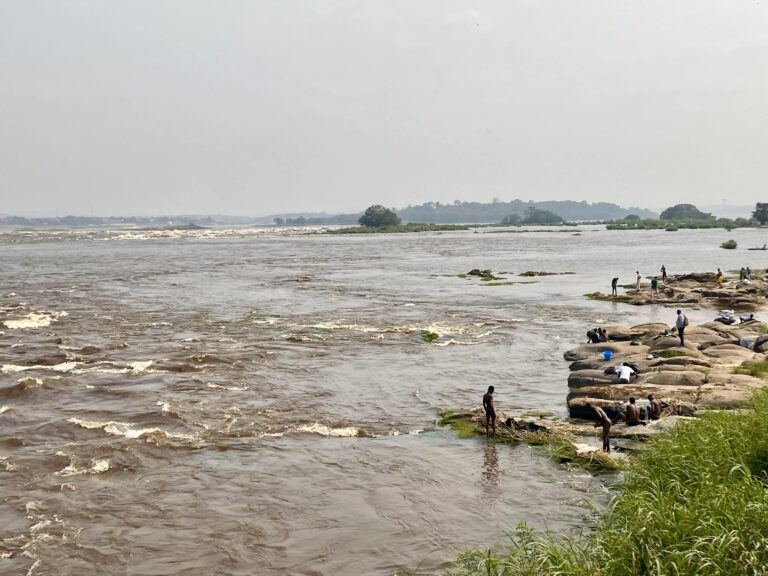
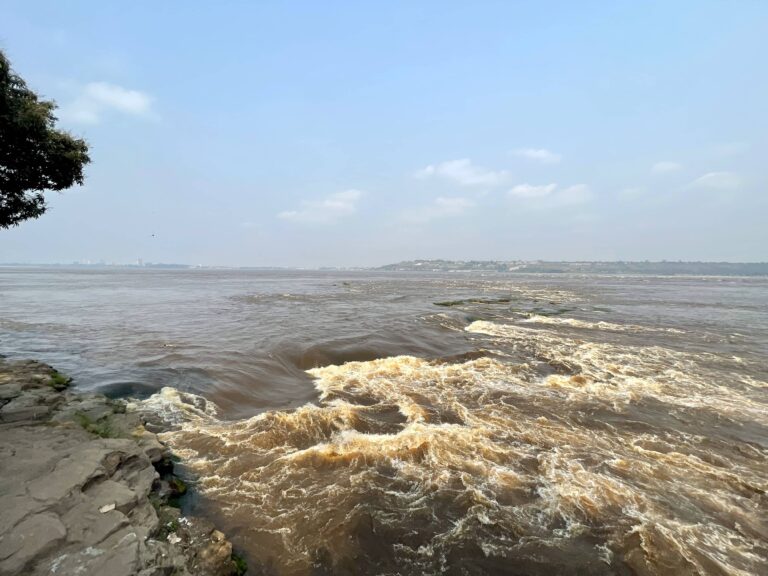
In the late 1870s the explorer Henry Morten Stanley spent three years tracing the Congo river’s course through nearly impenetrable jungle. Stanley’s expedition team – numbering in the hundreds, half of whom did not survive the trip – traveled in a collapsible boat which they regularly dismantled and carried overland, to bypass countless kilometers of unnavigable rapids.
This muddy brown churning torrent forms a natural border between the Congos, and separates the two closest capital cities in the world. Brazzaville, capital of the Republic of the Congo is a safe, comfortable, and (relatively speaking) calm city. But just across the river looms the less safe, messy, chaotic nightmare that is Kinshasa, capital of the Democratic Republic of the Congo.
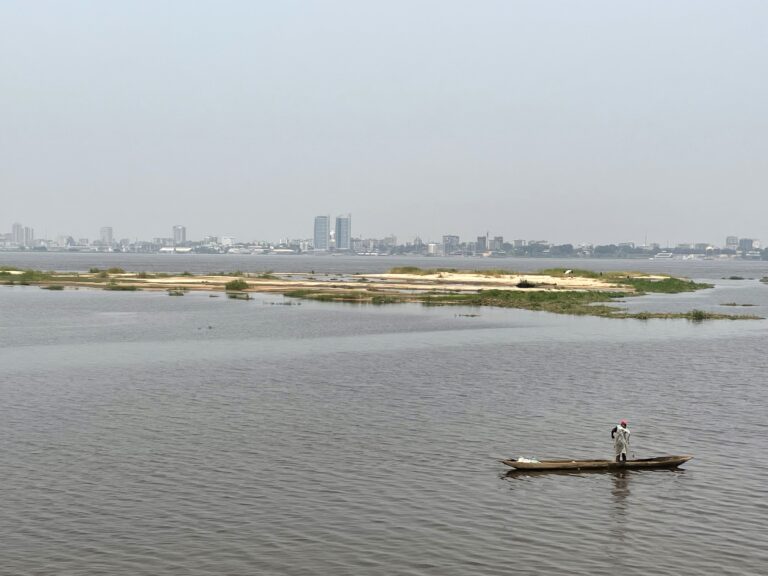
Assuming you’ve got the visa you can cross the Congo river in a ‘canot rapide’ – boats that make the trip from one city to the other in about fifteen minutes. Too easy? Don’t worry. Even though you won’t have to assemble the boat yourself, there’s a whole different set of obstacles in store for you. Clearing immigration and getting across the actual border itself is the challenge now, thanks to infamous levels of corruption.
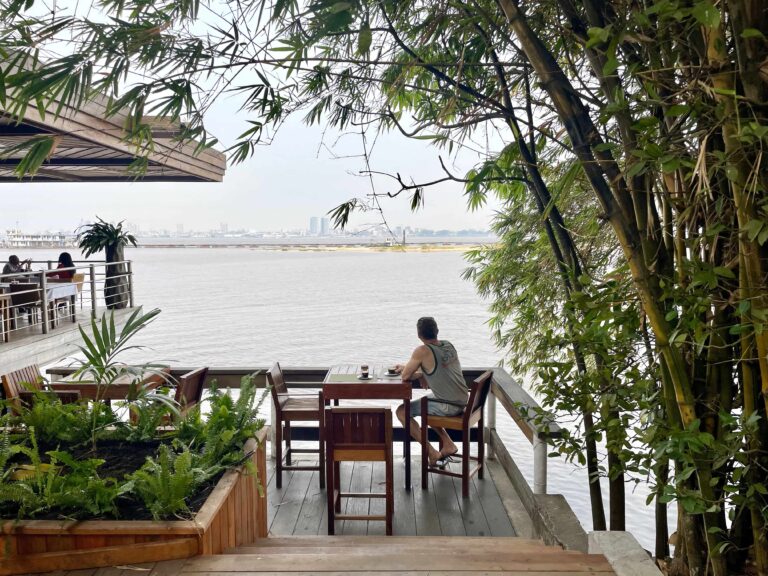
Still, crossing this mighty river from one Congo to the next has been pretty high on our ‘to do’ list for a while.
Brazzaville to Kinshasa. Or, out of the frying pan and into the fire.
Congo crossing
This border crossing requires some planning, a fair bit of patience, and could result in a severe headache, mainly if you tend to get upset about things like unbridled corruption and generally abhorrent behaviour on the part of officials.
This post isn’t a guide so much as an outline of how our day on the river crossing went. Just so you know, it went a LOT better than the day we traveled from Kinshasa to Matadi by road later on.
The moral of the story is: it can be done. It’s an exciting hop across a turbulent river that reflects the state of the two countries it divides, and a trip that I honestly will not ever forget.
So, if you ever wondered what it’s like crossing the river border between Republic of the Congo (ROC) and Democratic Republic of the Congo (DRC), then read on.
The DRC visa
By far, the biggest concern we had about this leg of our trip was the DRC visa. For us, getting this visa was a bit of a trial. We actually changed the starting point of our entire 14-month long trip because of it.
You need to get your DRC visa in advance, either in your home country or a in neighboring one on your way. Visa requirements in this region are often obscure and subject to change. Side note: Embassy/consulate locations change from time to time as well. The DRC’s new online visa portal was not working at that time either and I’ll bet it’s still not.
Long story short, if you live in a country where you can get the visa at home, do that.
There’s no DRC Embassy in our home country and it quickly became apparent that getting a visa from the closest one in Europe wasn’t going to happen. In a glimpse of the sort of behaviour to come in the Congo itself, the officer I talked to on the phone made all kinds of wild suggestions including that I should just mail him 500 USD in cash per visa, along with our passports.
So we scrapped that.
At the time, it wasn’t possible to get the DRC visa in Libreville (Gabon), which is where we were planning to start our trip. Why not pick it up next door in Republic of the Congo? Because only local residents can apply. Of course, the obvious way to surmount this obstacle is simply to become a resident of the Congo. Yep, after a lot of research I learned that for a few hundred bucks you can obtain residency and then head on over to the DRC Embassy in Brazzaville and get yourself a visa.
So we scrapped that too.
Eventually it transpired that our options in the area were Yaounde, Lagos, and Luanda. Luanda would only work if we were coming from the opposite direction. We didn’t want to back all the way up to Nigeria, hence our decision to start the trip in Cameroon. So we bought flights to Yaounde.
After a visit to the DRC Embassy in Yaounde and a few rounds with a surly security guard and an extremely unfriendly lady, we got the visas. It should have only taken two or three days but it took longer, since they insisted we go get our ROC visas first which doesn’t even make sense.
A month after we obtained it I read that the DRC Embassy in Yaounde no longer issues visas, but don’t hold me to that, it may have changed again.
Before you go
In West and Central Africa the security situation can change, sometimes quickly. Check the latest travel advice from your government and make sure your insurance is up to it.
Bring local currency and ideally USD. ROC uses the Central African CFA (XAF) and DRC uses the Congolese Franc. There were money changers in both ports.
Make sure your vaccines are up-to-date and you’ve got your International Vaccine Card with you to prove it. Otherwise you’re just opening yourself up to problems with the police, and they don’t need any more excuses.
The general consensus seems to be that you should hire a fixer to deal with the red tape and handle the ‘fees’ to get you across the river. Hiring a fixer is something we’ve never done before and we’ve always managed just fine. However, all we heard in this particular case is that without a fixer we’d face extreme (and expensive) hangups since this is one of the most corrupt border crossings around. A fixer will set it all up for you on both sides and the amount you pay him will include your ferry ticket, ‘fees’ for the officers, his counterpart to meet you on the other side, and his own fee.
In Brazzaville we stayed at Residence Hoteliere de Moungali where we met a fixer named Santa, who appears to be affiliated with the hotel without the hotel actually knowing about it. We went down to the port a day ahead to double-check things, and were approached immediately by a couple of potential fixers hanging around there with the same offer.
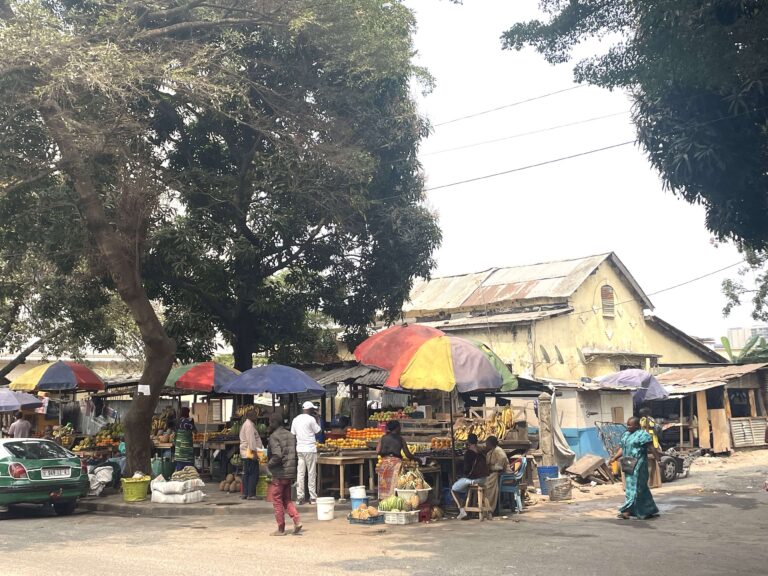
The route
Once you’ve gone to the trouble of getting to Brazzaville in the first place, the rest of the route is pretty straightforward: go to the port. Be mentally prepared for some hassle. There will be several checkpoints where you show documents and you or your fixer will fill out forms and pay various fees. Wait a long time while everyone including your own fixer tries to rip you off. Eventually, board the ‘canot rapide’ – the fast passenger ferry – and cross the river. Repeat a lot of this on the other side.
The border is open during regular daytime hours. As with any other border-crossing day, get an early start. Try to cross on a weekend, it’s supposedly less hectic.
Crossing the river border
Your first stop at the port is the ticket office window. I’m not sure the slow ferry is even an option – you should take the canot rapide. The price for Brazzaville to Kinshasa ticket was posted as 12,400 CFA.
Santa turned our border crossing trip into a family affair: he brought his ‘little sister’ and his nephew/apprentice. At the ticket office we gave our passports to the Apprentice, who ran off to take care of our tickets, stamps, and taxes.
Inside the port area Santa directed us to sit and wait on some wooden benches overlooking a shipwreck-waiting-to-happen pulled up on the muddy bank. The Apprentice was busy running around from office to office, so Santa had some spare time and he took this opportunity to lowkey harass us. He wanted taxi fare back from the port since he’d kindly come all this way; it suddenly occurred to him that we might require a Covid test; and so on. Then the man selling drinks near the wooden benches informed us we could no longer sit there without buying something.
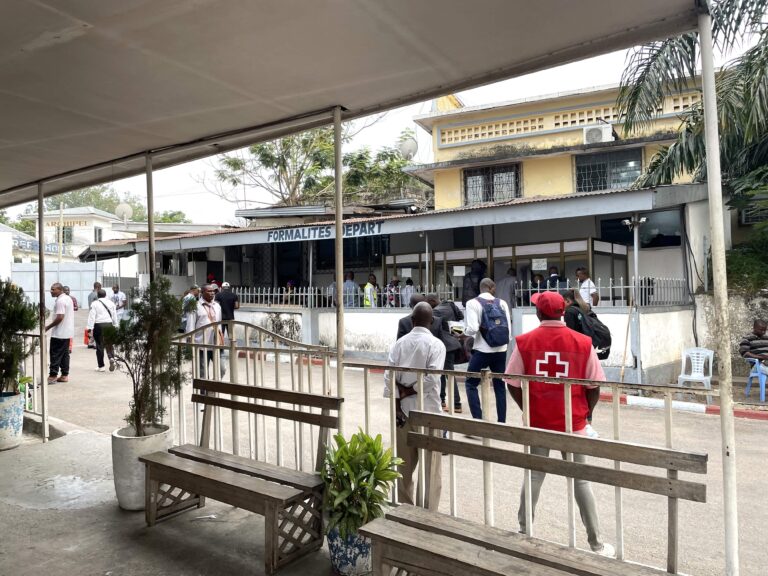
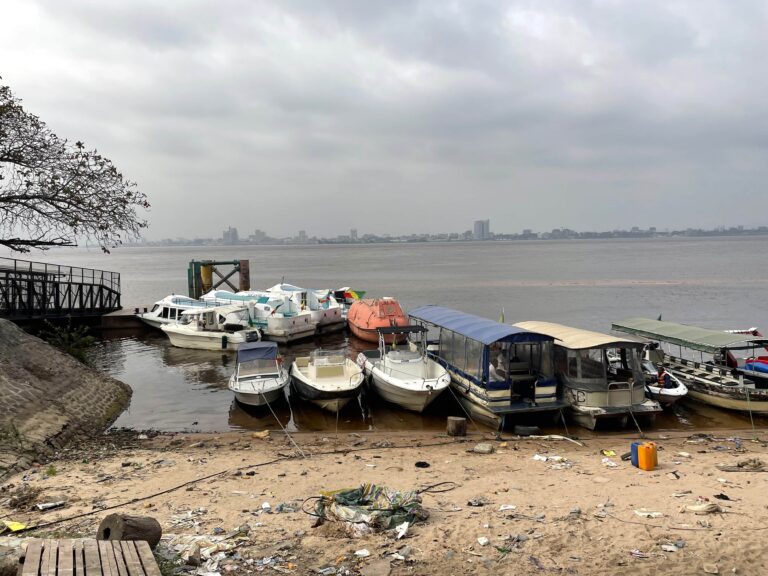
But when his Apprentice turned up with our stamped passports and tickets, Santa abandoned his fundraising efforts and was all business. He told us the name of our boat and showed us a photo of his counterpart on the other side. Then he and his sister walked us for a long time to where the boats were loading, and showed our passports and DRC visas to the police on the way.
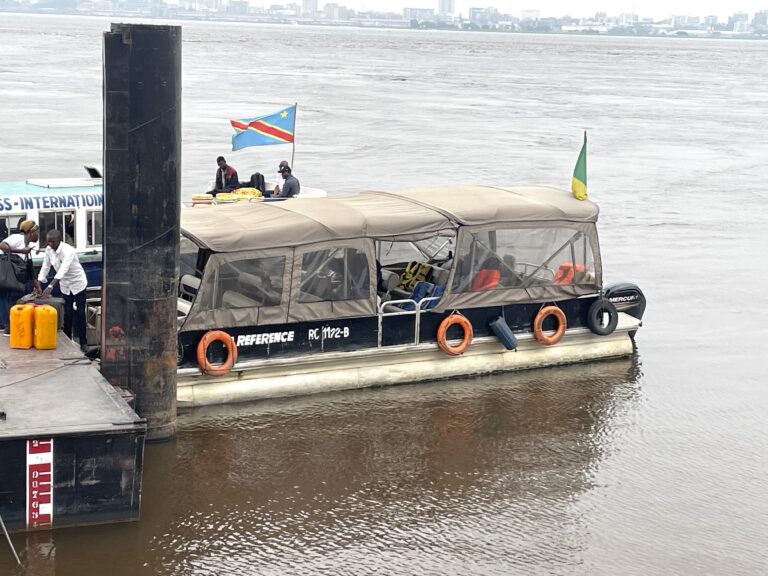
At the pier Santa pointed out our boat and reminded us to keep our phones out of sight in Kinshasa, and with that, we climbed aboard. The motor rumbled to life and we pulled away from the dock in the Republic of the Congo. I looked back at Santa and his sister watching us from the riverbank, arm-in-arm like parents seeing their kids off on the first day of school. For the most part Santa had been nothing but a thorn in our sides. But it was easy to feel fond of him now that we were waving goodbye from a boat speeding away to the DR Congo, and there was no going back.
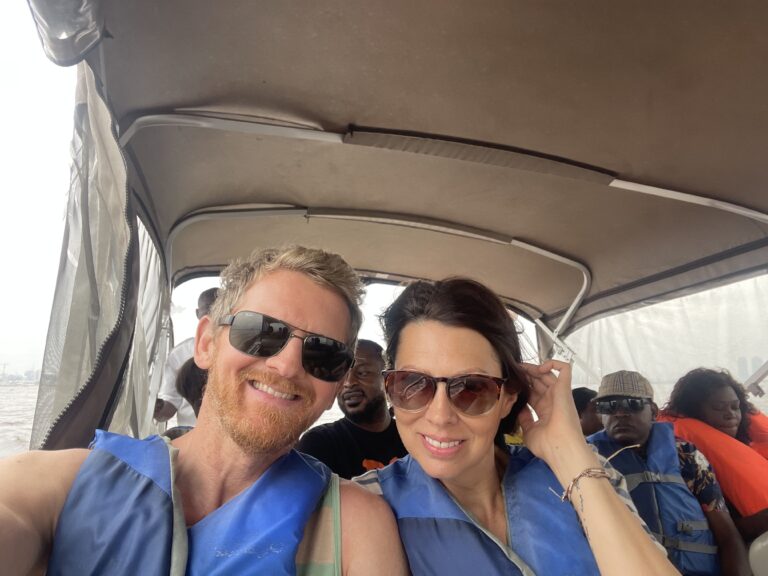
Fifteen minutes later we scrambled off the boat in the Democratic Republic of the Congo. Santa’s elf (a corrupt police officer) met us almost immediately and started directing us here and there. Around this point someone will demand your passport and take it away inside the building. You just have to wait around outside, hoping to see it again.
Sure enough, the elf came back out with our stamped passports, and we paid him the prearranged ‘stamp fee’.
And then we stepped out of the parking lot and right into the thick of Kinshasa.
So, fixer or DIY? It’s not a particularly confusing process. There’s a lot of queuing, waiting, answering questions, moving from one person to the next – just like any other border crossing. The tricky part is the ‘fees’: who gets them and how much, if at all. In retrospect we’re pretty sure we could have just done it ourselves without a fixer (although with the Apprentice doing the legwork it was certainly smoother and saved me a certain amount of rage).
There’s only one way to find out though, so stay tuned.
Kinshasa and moving on
Kinshasa, misleadingly nicknamed ‘Kin la belle’ by its inhabitants, is one of Africa’s fastest growing, sprawling mega-cities and has the noise, traffic, and pollution to match. It’s home to 17 000 000 people – many of whom fled their villages in the countryside during long years of war, instability, and extreme poverty, hoping for a better future. The city also boasts the largest Francophone urban population in the world. Throw in an Eric Kayser franchise and that sums up the similarities between Kinshasa and Paris.
There is a very noticeable police presence but contrary to what we’ve heard, not a single officer harassed us or asked for money (once we’d got past the immigration officers at the river border that is). Accommodation is expensive, infrastructure is pretty poor, you need to watch yourself and your stuff in the streets, traffic is about as dire as you’d expect and then some – we later spent an entire morning just trying to get out of the city, and the rest of that day is another story altogether.
But hey, start as you mean to go on – right?
Read More
For more of our adventures (and misadventures) as we travel from Cameroon to Japan, check out the rest of my stories from the road.
We’ve crossed a lot of borders by all sorts of random transport. Have a look at our border crossing reports and travel guides for strange stories and sage advice.
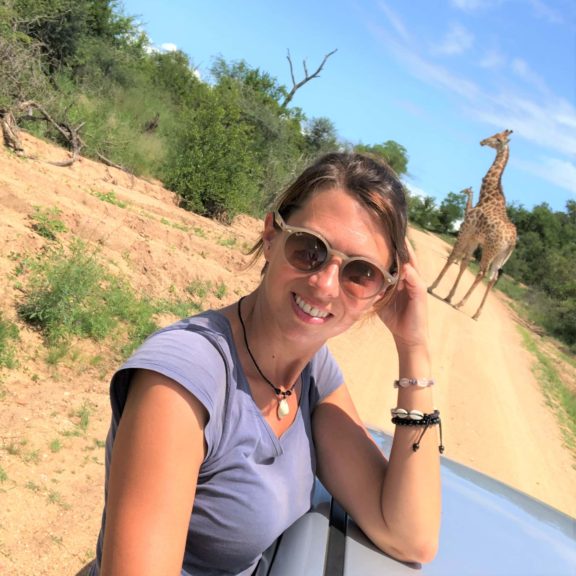
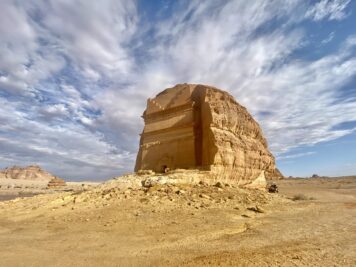
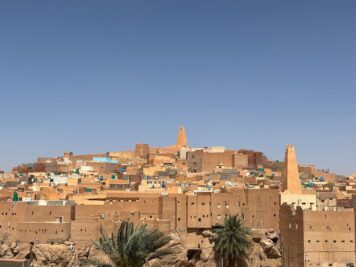
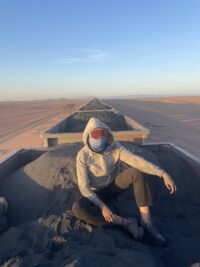
This Post Has 4 Comments
I have been trying to imagine this place since the first time I looked at the Congo river on google maps, nice to read about it and thanks for including pictures. What happens if the two connect I thought. Now I suspect both may be better off if they don’t. I will read the rest of our stories from the road to learn more.
I’ve always been fascinated by it too, was definitely an interesting experience:)
Very interesting escapades. Was even wondering the difference between DRC and the Congo Brazzaville.
Interesting exploration. What bothers me most now is hectic processes of inter border crossing and the fee payments due to corruption means to give way for passage. I will get more insight from the stories frm the road
Yes, the ‘fees’ are extreme, it’s really unfortunate.